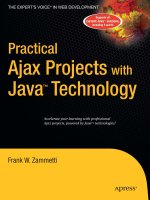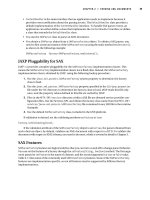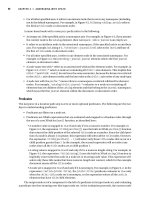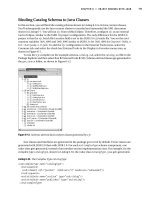Pro XML Development with Java Technology 2006 phần 9 pps
Bạn đang xem bản rút gọn của tài liệu. Xem và tải ngay bản đầy đủ của tài liệu tại đây (1.89 MB, 63 trang )
CHAPTER 11 ■ CONVERTING XML TO SPREADSHEET, AND VICE VERSA
307
case 8:
HSSFRow row8 = spreadsheet.getRow(8);
Element invincome1 = document.createElement("invincome");
stmtElement1.appendChild(invincome1);
invincome1.appendChild
(document.createTextNode
(row8.getCell((short) 1).
getStringCellValue()));
Element invincome2 = document.createElement("invincome");
stmtElement2.appendChild(invincome2);
invincome2.appendChild
(document.createTextNode
(row8.getCell((short) 2).
getStringCellValue()));
break;
case 9:
HSSFRow row9 = spreadsheet.getRow(9);
Element incbeforetaxes1 = document
.createElement("incbeforetaxes");
stmtElement1.appendChild(incbeforetaxes1);
incbeforetaxes1.appendChild
(document.createTextNode
(row9.getCell((short) 1).
getStringCellValue()));
Element incbeforetaxes2 =
document.createElement("incbeforetaxes");
stmtElement2.appendChild(incbeforetaxes2);
incbeforetaxes2.appendChild
(document.createTextNode
(row9.getCell((short)2).
getStringCellValue()));
break;
case 10:
HSSFRow row10 = spreadsheet.getRow(10);
Element taxes1 = document.createElement("taxes");
stmtElement1.appendChild(taxes1);
taxes1.appendChild(document.createTextNode(row10.getCell(
(short) 1).getStringCellValue()));
Element taxes2 = document.createElement("taxes");
stmtElement2.appendChild(taxes2);
Vohra_706-0C11.fm Page 307 Tuesday, August 8, 2006 6:43 AM
308
CHAPTER 11
■ CONVERTING XML TO SPREADSHEET, AND VICE VERSA
taxes2.appendChild(document.createTextNode(row10.getCell(
(short) 2).getStringCellValue()));
break;
case 11:
HSSFRow row11 = spreadsheet.getRow(11);
Element netincome1 = document.createElement("netincome");
stmtElement1.appendChild(netincome1);
netincome1.appendChild(document.createTextNode(row11
.getCell((short) 1).getStringCellValue()));
Element netincome2 = document.createElement("netincome");
stmtElement2.appendChild(netincome2);
netincome2.appendChild(document.createTextNode(row11
.getCell((short) 2).getStringCellValue()));
break;
default:
break;
}
}
TransformerFactory tFactory = TransformerFactory.newInstance();
Transformer transformer = tFactory.newTransformer();
//Add indentation to output
transformer.setOutputProperty
(OutputKeys.INDENT, "yes");
transformer.setOutputProperty(
"{ "2");
DOMSource source = new DOMSource(document);
StreamResult result = new StreamResult(System.out);
transformer.transform(source, result);
} catch (IOException e) {
System.out.println("IOException " + e.getMessage());
} catch (ParserConfigurationException e) {
System.out
.println("ParserConfigurationException " + e.getMessage());
} catch (TransformerConfigurationException e) {
System.out.println("TransformerConfigurationException "
+ e.getMessage());
} catch (TransformerException e) {
System.out.println("TransformerException " + e.getMessage());
}
}
Vohra_706-0C11.fm Page 308 Tuesday, August 8, 2006 6:43 AM
CHAPTER 11 ■ CONVERTING XML TO SPREADSHEET, AND VICE VERSA
309
public static void main(String[] argv) {
ExcelToXML excel = new ExcelToXML();
File input = new File("IncomeStatements.xls");
excel.generateXML(input);
}
}
You can run the application ExcelToXML.java in Eclipse with the procedure explained in
Chapter 1. Listing 11-16 shows the output from the ExcelToXML.java application.
Listing 11-16. Output from ExcelToXML.java
<?xml version="1.0" encoding="UTF-8"?>
<incmstmts>
<stmt>
<year>2005</year>
<revenue>11837</revenue>
<costofrevenue>2239</costofrevenue>
<researchdevelopment>1591</researchdevelopment>
<salesmarketing>2689</salesmarketing>
<generaladmin>661</generaladmin>
<totaloperexpenses>7180</totaloperexpenses>
<operincome>4657</operincome>
<invincome>480</invincome>
<incbeforetaxes>5137</incbeforetaxes>
<taxes>1484</taxes>
<netincome>3653</netincome>
</stmt>
<stmt>
<year>2004</year>
<revenue>10818</revenue>
<costofrevenue>1875</costofrevenue>
<researchdevelopment>1421</researchdevelopment>
<salesmarketing>2122</salesmarketing>
<generaladmin>651</generaladmin>
<totaloperexpenses>6069</totaloperexpenses>
<operincome>4749</operincome>
<invincome>420</invincome>
<incbeforetaxes>5169</incbeforetaxes>
<taxes>1706</taxes>
<netincome>3463</netincome>
</stmt>
</incmstmts>
Summary
The Apache POI API provides a useful mechanism for converting data between XML and spreadsheets.
In this chapter, you learned how to convert an example XML document to an Excel spreadsheet and
then convert the spreadsheet to an XML document. With XML being a universal format, there really
is no limit to what you can do with it!
Vohra_706-0C11.fm Page 309 Tuesday, August 8, 2006 6:43 AM
Vohra_706-0C11.fm Page 310 Tuesday, August 8, 2006 6:43 AM
311
■ ■ ■
CHAPTER 12
Converting XML to PDF
In the previous chapter, we discussed the procedure to convert an XML document to a Microsoft
Excel spreadsheet. In this chapter, we will show how to convert an XML document to a PDF document.
The open source Apache Formatting Objects Processor (FOP) project provides an API to convert an
XML document to PDF or other formats such as Printer Control Language (PCL), PostScript (PS),
Scalable Vector Graphics (SVG), XML, Print, Abstract Window Toolkit (AWT), Maker Interchange
Format (MIF), or TXT. You can also set the layout and font with the Apache FOP API. The Apache
FOP takes an XSL formatting object (an XSL-FO object) as input and produces a PDF (or other format)
document as output. XSL-FO is defined in the XSL 1.0 specification.
1
Therefore, to convert XML to
PDF, you first need to convert XML to XSL-FO and subsequently convert XSL-FO to PDF.
Installing the Software
Before you can set up your project, you need to download the Apache FOP
2
zip file fop-0.20.5-bin.zip
and extract the zip file to a directory. Assuming <FOP> is the directory in which you extracted the FOP
zip file, you need the JAR files listed in Table 12-1 for developing an XML to PDF conversion application.
You also need to download JDK 5.0. (You can also use another version of the JDK such as 1.4
or 6.0.)
1. See />2. For more information about Apache FOP, see />Table 12-1. Apache FOP JAR Files
JAR File Description
<FOP>/build/fop.jar FOP API classes
<FOP>/lib/avalon-framework-cvs-20020806.jar Logger classes
<FOP>/lib/batik.jar Graphics classes
<FOP>/lib/xercesImpl-2.2.1.jar The Xerces API
<FOP>/lib/xml-apis.jar The XML API
<FOP>/lib/xalan-2.4.1.jar The XSLT API
Vohra_706-0C12.fm Page 311 Saturday, July 29, 2006 6:20 AM
312
CHAPTER 12
■ CONVERTING XML TO PDF
Setting Up the Eclipse Project
To compile and run the code examples, you will need an Eclipse project. You can download project
Chapter12 from the Apress website () and import it into your Eclipse work-
space by selecting File ➤ Import. The Chapter12 project consists of a com.apress.pdf package and
the Java class XMLToPDF.java in the package. The XMLToPDF.java application performs the XML to
PDF conversion. The Chapter12 project also consists of an example XML document (catalog.xml
in Listing 12-1) and an example XSLT style sheet (catalog.xslt in Listing 12-2).
To compile and run the XML to PDF code example, you need some Apache FOP JAR files in your
project’s Java build path; Figure 12-1 shows these JAR files. You also need to set the JRE system library
to JRE 5.0, as shown in Figure 12-1.
Figure 12-1. Chapter12 Java build path
Figure 12-2 shows the Chapter12 project directory structure.
Vohra_706-0C12.fm Page 312 Saturday, July 29, 2006 6:20 AM
CHAPTER 12 ■ CONVERTING XML TO PDF
313
Figure 12-2. Chapter12 Project directory structure
Converting an XML Document to XSL-FO
An XSL-FO formatting object includes formatting information about the data to be presented in
a PDF document, the layout and fonts used in the document, and the tables in the document. To
convert an XML document to a PDF document, first you need to convert the XML document to an
XSL-FO document. The procedure to convert an XML document to an XSL-FO document is as follows:
1. Create an XSLT to transform XML to XSL-FO.
2. Set the parser and transformer system properties.
3. Create a Document object from the XML document.
4. Create a Transformer object.
5. Transform the XML document to an XSL-FO document.
An XSL-FO document is in the FO namespace. Therefore, an XSL-FO document includes a
namespace declaration, xmlns:fo= in the root element fo:root.
Table 12-2 lists some of commonly used elements in an XSL-FO document.
Table 12-2. XSL-FO Elements
Element Attributes Subelements Description
fo:root xmlns:fo fo-layout-master-set,
fo-page-sequence
Root element in an
XSL-FO document
fo:layout-master-set fo:simple-page-master Consists of a set of
page masters (at
least one page
master is required)
fo:simple-page-master margin-right, margin-left,
margin-bottom, margin-top,
page-width, page-height,
master-name
fo:region-body Specifies page layout
Vohra_706-0C12.fm Page 313 Saturday, July 29, 2006 6:20 AM
314
CHAPTER 12
■ CONVERTING XML TO PDF
The DTD for the XSL-FO object is available from />fo2000.dtd.html. In this section, we will show how to convert an example XML document, catalog.xml,
to an XSL-FO document using XSLT. Listing 12-1 shows the example XML document, catalog.xml.
Listing 12-1. catalog.xml
<?xml version="1.0" encoding="UTF-8"?>
<catalog>
<journal>
<section>Java Technology</section>
<publisher>IBM developerWorks</publisher>
<level>Introductory</level>
<edition>Nov-2004</edition>
<title>Getting started with enumerated types</title>
<author>Brett McLaughlin</author>
</journal>
<journal>
<section>Java Technology</section>
fo:page-sequence master-reference fo:title,
fo:static-content,
fo:flow
Specifies the order of
page masters
fo:flow flow-name fo:block Page content
fo:block space-before, space-after,
font-weight, font-size
fo:table,
fo:list-block
Base element for
page content;
includes formatting
information.
fo:list-block provisional-distance-
between-starts,
provisional-label-separation
fo:list-item Specifies a block that
includes a list
fo:list-item text-indent fo:list-item-label,
fo:list-item-body
Specifies a list item
fo:table border-spacing, table-layout fo:table-column,
fo:table-header,
fo:table-body
Specifies a table in a
page
fo:table-column column-number,
column-width
Column in a table
fo:table-header fo:table-row Table header
fo:table-body table-layout fo:table-row Table rows
fo:table-row font-weight fo:table-cell Row in a table
fo:table-cell column-number fo:block Row cell that has the
text of a row cell
Table 12-2. XSL-FO Elements (Continued)
Element Attributes Subelements Description
Vohra_706-0C12.fm Page 314 Saturday, July 29, 2006 6:20 AM
CHAPTER 12 ■ CONVERTING XML TO PDF
315
<publisher>IBM developerWorks</publisher>
<level>Intermediate</level>
<edition>Sep-2004</edition>
<title>Migrating to Eclipse</title>
<author>David Gallardo</author>
</journal>
<journal>
<section>Java Technology</section>
<publisher>IBM developerWorks</publisher>
<level>Intermediate</level>
<edition>Jan-2004</edition>
<title>Design service-oriented architecture frameworks with J2EE technology</title>
<author>Naveen Balani</author>
</journal>
</catalog>
The Apache FOP API generates a PDF document from an XSL-FO document. The PDF docu-
ment presents the XML document data in the form of a table. Therefore, you first need to convert the
example XML document to an XSL-FO document using XSLT. An XSLT style sheet that converts XML
to XSL-FO retrieves data from the XML document and, using elements in the XSL-FO namespace,
creates a formatting object representation of the XML data. (Table 12-2 discussed the XSL-FO
namespace elements.) Listing 12-2 shows the example XSLT document, catalog.xslt, to convert
the example document to an XSL-FO document.
Listing 12-2. catalog.xslt
<?xml version="1.0" encoding="UTF-8"?>
<xsl:stylesheet version="1.1" xmlns:xsl=" /> xmlns:fo=" exclude-result-prefixes="fo">
<xsl:output method="xml" version="1.0" omit-xml-declaration="no" indent="yes"/>
<! ========================= >
<! root element: catalog >
<! ========================= >
<xsl:template match="/catalog">
<fo:root xmlns:fo=" /><! Setting up the Font and the Pages >
<fo:layout-master-set>
<fo:simple-page-master master-name="simpleA4" page-height="29.7cm"
page-width="75cm" margin-top="2cm" margin-bottom="2cm"
margin-left="5cm" margin-right="5cm">
<fo:region-body/>
</fo:simple-page-master>
</fo:layout-master-set>
<fo:page-sequence master-reference="simpleA4">
<fo:flow flow-name="xsl-region-body">
<fo:block font-size="40pt"
font-weight="bold" text-align="center"
space-after="5mm">
Catalog
</fo:block>
<fo:block font-size="25pt">
Vohra_706-0C12.fm Page 315 Saturday, July 29, 2006 6:20 AM
316
CHAPTER 12
■ CONVERTING XML TO PDF
<fo:table table-layout="fixed">
<fo:table-column column-width="10cm"/>
<fo:table-column column-width="10cm"/>
<fo:table-column column-width="10cm"/>
<fo:table-column column-width="10cm"/>
<fo:table-column column-width="10cm"/>
<fo:table-column column-width="10cm"/>
<! Setting up the header >
<fo:table-header>
<fo:table-row font-weight="bold"><fo:table-cell>
<fo:block>
<xsl:text>Section</xsl:text>
</fo:block>
</fo:table-cell>
<fo:table-cell>
<fo:block>
<xsl:text>Publisher</xsl:text>
</fo:block>
</fo:table-cell>
<fo:table-cell>
<fo:block>
<xsl:text>Level</xsl:text>
</fo:block>
</fo:table-cell>
<fo:table-cell>
<fo:block>
<xsl:text>Edition</xsl:text>
</fo:block>
</fo:table-cell>
<fo:table-cell>
<fo:block>
<xsl:text>Title</xsl:text>
</fo:block>
</fo:table-cell>
<fo:table-cell>
<fo:block>
<xsl:text>Author</xsl:text>
</fo:block>
</fo:table-cell>
</fo:table-row>
</fo:table-header>
<fo:table-body>
<! Calling template to add data from XML document to XSL-FO Table >
<xsl:apply-templates select="journal"/>
</fo:table-body>
</fo:table>
</fo:block>
</fo:flow>
</fo:page-sequence>
<! End of root element of XSL-FO document >
</fo:root>
Vohra_706-0C12.fm Page 316 Saturday, July 29, 2006 6:20 AM
CHAPTER 12 ■ CONVERTING XML TO PDF
317
</xsl:template>
<! Template to add data to XSL-FO document >
<xsl:template match="journal">
<fo:table-row>
<fo:table-cell>
<fo:block>
<xsl:value-of select="section"/>
</fo:block>
</fo:table-cell>
<fo:table-cell>
<fo:block>
<xsl:value-of select="publisher"/>
</fo:block>
</fo:table-cell>
<fo:table-cell>
<fo:block>
<xsl:value-of select="level"/>
</fo:block>
</fo:table-cell>
<fo:table-cell>
<fo:block>
<xsl:value-of select="edition"/>
</fo:block>
</fo:table-cell>
<fo:table-cell>
<fo:block>
<xsl:value-of select="title"/>
</fo:block>
</fo:table-cell>
<fo:table-cell>
<fo:block>
<xsl:value-of select="author"/>
</fo:block>
</fo:table-cell>
</fo:table-row>
</xsl:template>
</xsl:stylesheet>
Setting the System Properties
You perform the XML to XSL-FO transformation using the Transformation API for XML, which
was discussed in Chapter 5. You will parse the example XML document using a DocumentBuilder
parser and transform it using a Transformer object. So, you need to set the system properties
javax.xml.parsers.DocumentBuilderFactory and javax.xml.transform.TransformerFactory,
as shown in Listing 12-3. You use DocumentBuilderFactory to create a DocumentBuilder object
and TransformerFactory to create a Transformer object.
Vohra_706-0C12.fm Page 317 Saturday, July 29, 2006 6:20 AM
318
CHAPTER 12
■ CONVERTING XML TO PDF
Listing 12-3. Setting System Properties
System.setProperty("javax.xml.parsers.DocumentBuilderFactory",
"org.apache.xerces.jaxp.DocumentBuilderFactoryImpl");
System.setProperty
("javax.xml.transform.TransformerFactory",
"org.apache.xalan.processor.TransformerFactoryImpl");
Creating a Document
You can create a Document object by parsing an XML document with a DocumentBuilder object.
You obtain a DocumentBuilder object from a DocumentBuilderFactory object. Therefore, you need to
create a DocumentBuilderFactory object using the static method newInstance(). Subsequently, create
a DocumentBuilder object from the DocumentBuilderFactory object using the method
newDocumentBuilder(), as shown in Listing 12-4. You can parse an XML document using one of the
overloaded parse() methods from an InputStream, an InputSource, or a File. The example applica-
tion parses the XML document from a File object, as shown in Listing 12-4. The parse(File) object
returns a Document object.
Listing 12-4. Parsing an XML Document
DocumentBuilderFactory factory = DocumentBuilderFactory.newInstance();
DocumentBuilder builder = factory.newDocumentBuilder();
Document document = builder.parse(new File("catalog.xml"));
Creating a Transformer
You also need to create a Transformer object to transform the Document object obtained with a
DocumentBuilder object. You can obtain a Transformer object from a TransformerFactory object.
Therefore, create a TransformerFactory object using the static method newInstance(), as shown in
Listing 12-5. To set a stylesheet on the Transformer object obtained from the TransformerFactory
object, create a StreamSource object from the example style sheet. Subsequently, create a Transformer
object using the method newTransformer(StyleSource).
Listing 12-5. Creating a Transformer Object
TransformerFactory tFactory = TransformerFactory.newInstance();
StreamSource stylesource = new StreamSource(new File("catalog.xslt"));
Transformer transformer = tFactory.newTransformer(stylesource);
Transforming the XML Document to XSL-FO
The Transformer class provides the method transform(Source, Result) to transform XML input
to output. You can specify the input as DOMSource, SAXSource, or StreamSource. You can specify the
output as DOMResult, SAXResult, or StreamResult. In the example application, input is specified as
DOMSource, and output is specified as StreamResult. Therefore, create a DOMSource object from the
Document object, and create a StreamResult object from a catalog.fo file, as shown in Listing 12-6.
Subsequently, transform the example XML document using the transform(DOMSource, SAXResult)
object, as shown in Listing 12-6.
Vohra_706-0C12.fm Page 318 Saturday, July 29, 2006 6:20 AM
CHAPTER 12 ■ CONVERTING XML TO PDF
319
Listing 12-6. Transforming an XML Document to XSL-FO
DOMSource source = new DOMSource(document);
StreamResult result = new StreamResult("catalog.fo");
transformer.transform(source, result);
The XSL-FO document, catalog.fo, presents the XML document data in the form of a table. The
layout-master-set element specifies the page layout and page characteristics such as the page margins,
page width, and page height. The element page-sequence defines an XSL-FO page. Fo-block elements
specify the page content. The fo-table element defines a table. Listing 12-7 shows the XSL-FO docu-
ment generated from the transformation.
Listing 12-7. catalog.fo
<?xml version="1.0" encoding="UTF-8"?>
<fo:root xmlns:fo=" /><fo:layout-master-set>
<fo:simple-page-master margin-right="5cm"
margin-left="5cm" margin-bottom="2cm"
margin-top="2cm" page-width="75cm"
page-height="29.7cm" master-name="simpleA4">
<fo:region-body/>
</fo:simple-page-master>
</fo:layout-master-set>
<fo:page-sequence master-reference="simpleA4">
<fo:flow flow-name="xsl-region-body">
<fo:block space-after="5mm" text-align="center" font-weight="bold" font-size="40pt">
Catalog
</fo:block>
<fo:block font-size="25pt">
<fo:table table-layout="fixed">
<fo:table-column column-width="10cm"/>
<fo:table-column column-width="10cm"/>
<fo:table-column column-width="10cm"/>
<fo:table-column column-width="10cm"/>
<fo:table-column column-width="10cm"/>
<fo:table-column column-width="10cm"/>
<fo:table-header>
<fo:table-row font-weight="bold">
<fo:table-cell>
<fo:block>Section</fo:block>
</fo:table-cell>
<fo:table-cell>
<fo:block>Publisher</fo:block>
</fo:table-cell>
<fo:table-cell>
<fo:block>Level</fo:block>
</fo:table-cell>
<fo:table-cell>
<fo:block>Edition</fo:block>
</fo:table-cell>
<fo:table-cell>
<fo:block>Title</fo:block>
</fo:table-cell>
<fo:table-cell>
Vohra_706-0C12.fm Page 319 Saturday, July 29, 2006 6:20 AM
320
CHAPTER 12
■ CONVERTING XML TO PDF
<fo:block>Author</fo:block>
</fo:table-cell>
</fo:table-row>
</fo:table-header>
<fo:table-body>
<fo:table-row>
<fo:table-cell>
<fo:block>Java Technology</fo:block>
</fo:table-cell>
<fo:table-cell>
<fo:block>IBM developerWorks</fo:block>
</fo:table-cell>
<fo:table-cell>
<fo:block>Introductory</fo:block>
</fo:table-cell>
<fo:table-cell>
<fo:block>Nov-2004</fo:block>
</fo:table-cell>
<fo:table-cell>
<fo:block>Getting started with enumerated types</fo:block>
</fo:table-cell>
<fo:table-cell>
<fo:block>Brett McLaughlin</fo:block>
</fo:table-cell>
</fo:table-row>
<fo:table-row>
<fo:table-cell>
<fo:block>Java Technology</fo:block>
</fo:table-cell>
<fo:table-cell>
<fo:block>IBM developerWorks</fo:block>
</fo:table-cell>
<fo:table-cell>
<fo:block>Intermediate</fo:block>
</fo:table-cell>
<fo:table-cell>
<fo:block>Sep-2004</fo:block>
</fo:table-cell>
<fo:table-cell>
<fo:block>Migrating to Eclipse</fo:block>
</fo:table-cell>
<fo:table-cell>
<fo:block>David Gallardo</fo:block>
</fo:table-cell>
</fo:table-row>
<fo:table-row>
<fo:table-cell>
<fo:block>Java Technology</fo:block>
</fo:table-cell>
<fo:table-cell>
<fo:block>IBM developerWorks</fo:block>
</fo:table-cell>
<fo:table-cell>
<fo:block>Intermediate</fo:block>
Vohra_706-0C12.fm Page 320 Saturday, July 29, 2006 6:20 AM
CHAPTER 12 ■ CONVERTING XML TO PDF
321
</fo:table-cell>
<fo:table-cell>
<fo:block>Jan-2004</fo:block>
</fo:table-cell>
<fo:table-cell>
<fo:block>Design service-oriented architecture
frameworks with J2EE technology</fo:block>
</fo:table-cell>
<fo:table-cell>
<fo:block>Naveen Balani</fo:block>
</fo:table-cell>
</fo:table-row>
</fo:table-body>
</fo:table>
</fo:block>
</fo:flow>
</fo:page-sequence>
</fo:root>
Generating a PDF Document
In the following sections, you will generate a PDF document from the XSL-FO document, catalog.fo,
with the Apache FOP API. The procedure to generate a PDF document from an XSL-FO document is
as follows:
1. Create a FOP driver.
2. Set the FOP driver renderer to the PDF renderer.
3. Specify the input for the XSL-FO document and the output for the PDF document.
4. Run the FOP driver to generate the PDF document.
You need to import the Apache FOP packages org.apache.fop.apps and org.apache.avalon.
framework.logger to the XMLToPDF.java application.
Creating a FOP Driver
To convert the XSL-FO document to a PDF document, you need to create a FOP driver object, as
shown in Listing 12-8. You also need to create a console logger with the level setting LEVEL_INFO and
set the logger on the FOP driver and MessageHandler. You can also set the logger level to LEVEL_DEBUG,
LEVEL_DISABLED, LEVEL_ERROR, LEVEL_FATAL, or LEVEL_WARN. ConsoleLogger outputs to the standard
output stream. You can also use a BufferedLogger, which outputs to a StringBuffer. The MessageHandler
class generates the message output. By default, MessageHandler outputs to the screen. You can also
configure the MessageHandler class to output to a file. The setScreenLogger(Logger) method sets the
screen logger of the MessageHandler class.
Listing 12-8. Creating a FOP Driver
Driver driver=new Driver();
Logger logger=new ConsoleLogger(ConsoleLogger.LEVEL_INFO);
driver.setLogger(logger);
org.apache.fop.messaging.MessageHandler.setScreenLogger(logger);
Vohra_706-0C12.fm Page 321 Saturday, July 29, 2006 6:20 AM
322
CHAPTER 12
■ CONVERTING XML TO PDF
You can render an XSL-FO document to various output types using the corresponding renderer.
Table 12-3 lists the different rendering types supported by the FOP driver.
Converting XSL-FO to PDF
Because you will be converting an XSL-FO document to a PDF document, set the renderer type to
Driver.RENDER_PDF, as shown here:
driver.setRenderer(Driver.RENDER_PDF);
You need to specify the input XSL-FO document for the FOP driver, as shown next. You set the
XSL-FO document as input using the setInputSource(InputSource) method.
InputStream input=new FileInputStream(new File("catalog.fo")));
driver.setInputSource(new InputSource(input));
You also need to set the output for the PDF document generated with the FOP driver. You set
the output using the method setOutputStream(OutputStream), as shown here:
OutputStream output=new FileOutputStream(new File("catalog.pdf")));
driver.setOutputStream(output);
To generate a PDF document from the XSL-FO document, run the FOP driver using the method
run(), as shown next. Subsequently, close the Driver object using the close() method.
driver.run();
output.flush();
output.close();
Viewing the Complete Example
Listing 12-9 shows the Java application, XMLToPDF.java, for converting an XML document to a PDF
document. The application consists of the methods generateXSLFO(File xmlFile, File xsltFile)
and generatePDF(). In the generateXSLFO() method, a DocumentBuilder parses an XML document to
obtain a Document object, and a Transformer transforms the Document object to an XSL-FO file using
a stylesheet. In the generatePDF() method, a FOP driver converts the XSL-FO file to a PDF document.
Table 12-3. Renderer Types
Render Type Description
RENDER_PDF Renders to a PDF document
RENDER_AWT Renders to a GUI window
RENDER_MIF Renders to MIF
RENDER_XML Renders to an XML document
RENDER_PCL Renders to a PCL document
RENDER_PS Renders to a Postscript document
RENDER_TXT Renders to a text document
RENDER_SVG Renders to SVG
Vohra_706-0C12.fm Page 322 Saturday, July 29, 2006 6:20 AM
CHAPTER 12 ■ CONVERTING XML TO PDF
323
Listing 12-9. XMLToPDF.java
package com.apress.pdf;
import org.apache.fop.apps.*;
import org.apache.avalon.framework.logger.*;
import java.io.*;
import org.xml.sax.InputSource;
import javax.xml.parsers.*;
import org.xml.sax.*;
import org.w3c.dom.*;
import javax.xml.transform.*;
import javax.xml.transform.dom.*;
import javax.xml.transform.stream.*;
public class XMLToPDF {
public void generateXSLFO(File xmlFile, File xsltFile) {
try {
System.setProperty
("javax.xml.parsers.DocumentBuilderFactory",
"org.apache.xerces.jaxp.DocumentBuilderFactoryImpl");
System.setProperty("javax.xml.transform.TransformerFactory",
"org.apache.xalan.processor.TransformerFactoryImpl");
// Create a DocumentBuilderFactory
DocumentBuilderFactory factory = DocumentBuilderFactory
.newInstance();
// Create DocumentBuilder object
DocumentBuilder builder = factory.newDocumentBuilder();
// Parse example XML Document
Document document = builder.parse(xmlFile);
// Create a TransformerFactory object
TransformerFactory tFactory = TransformerFactory.newInstance();
// Create a Stylesource object from the style sheet File object
StreamSource stylesource = new StreamSource(xsltFile);
// Create a Transformer object from the StyleSource object
Transformer transformer = tFactory.newTransformer(stylesource);
// Create a DOMSource object from an XML document
DOMSource source = new DOMSource(document);
// Create a StreamResult object to output the result of a
// transformation
StreamResult result = new StreamResult("catalog.fo");
// Transform an XML document with an XSLT style sheet
transformer.transform(source, result);
} catch (TransformerConfigurationException e) {
System.out.println(e.getMessage());
Vohra_706-0C12.fm Page 323 Saturday, July 29, 2006 6:20 AM
324
CHAPTER 12
■ CONVERTING XML TO PDF
} catch (TransformerException e) {
System.out.println(e.getMessage());
} catch (SAXException e) {
System.out.println(e.getMessage());
} catch (ParserConfigurationException e) {
System.out.println(e.getMessage());
} catch (IOException e) {
System.out.println(e.getMessage());
}
}
public void generatePDF() {
try { //Create a FOP driver
Driver driver = new Driver();
//Create and set a logger on the driver
Logger logger = new ConsoleLogger(ConsoleLogger.LEVEL_INFO);
driver.setLogger(logger);
org.apache.fop.messaging.MessageHandler.setScreenLogger(logger);
//Set renderer type
driver.setRenderer(Driver.RENDER_PDF);
//Set input and output
InputStream input = new FileInputStream(new File("catalog.fo"));
driver.setInputSource(new InputSource(input));
OutputStream output = new FileOutputStream(new File("catalog.pdf"));
driver.setOutputStream(output);
//Run FOP driver
driver.run();
output.flush();
output.close();
} catch (IOException e) {
} catch (org.apache.fop.apps.FOPException e) {
System.out.println(e.getMessage());
}
}
public static void main(String[] argv) {
XMLToPDF xmlToPDF = new XMLToPDF();
File xmlFile = new File("catalog.xml");
File xsltFile = new File("catalog.xslt");
xmlToPDF.generateXSLFO(xmlFile, xsltFile);
xmlToPDF.generatePDF();
}
}
Vohra_706-0C12.fm Page 324 Saturday, July 29, 2006 6:20 AM
CHAPTER 12 ■ CONVERTING XML TO PDF
325
You can run the application XMLToPDF.java in Eclipse with the procedure explained in Chapter 1.
Listing 12-10 shows the output generated from the application. As shown in the output, org.pache.
xerces.parsers.SAXParser parses the XSL-FO object.
Listing 12-10. Output from Converting XSL-FO to PDF
[INFO] Using org.apache.xerces.parsers.SAXParser as SAX2 Parser
[INFO] building formatting object tree
[INFO] setting up fonts
[INFO] [1]
[INFO] Parsing of document complete, stopping renderer
The PDF document catalog.pdf gets generated and added to the Chapter12 project, as shown
in Figure 12-3.
Figure 12-3. Chapter12 project directory structure including catalog.pdf
Summary
In this chapter, you learned how to convert an example XML document to a PDF document. You can
also generate other output types such as AWT, MIF, XML, PCL, PS, TXT, and SVG using the corre-
sponding renderer. To convert an XML document to a PDF document, first you convert the XML
document to an XSL-FO document, and subsequently you convert the XSL-FO document to a
PDF document. You convert the XML document to an XSL-FO document using an XSLT stylesheet
and the Transformer API. You can convert the XSL-FO document to a PDF document using the
FOP driver.
Vohra_706-0C12.fm Page 325 Saturday, July 29, 2006 6:20 AM
Vohra_706-0C12.fm Page 326 Saturday, July 29, 2006 6:20 AM
■ ■ ■
PART 6
Web Applications
and Services
Vohra_706-0C13.fm Page 327 Saturday, July 29, 2006 5:45 AM
Vohra_706-0C13.fm Page 328 Saturday, July 29, 2006 5:45 AM
329
■ ■ ■
CHAPTER 13
Building Web Applications with Ajax
Asynchronous JavaScript and XML (Ajax) is a term, coined by Jesse James Garrett of Adaptive
Path,
1
used to describe a web technique that allows you to create asynchronous web applications
using JavaScript, the Document Object Model (DOM), and XMLHttpRequest technologies. Using this
technique, a browser-based user interface can interact with the server to update selected parts of a
web page without having to reload the web page.
This web technique decreases the amount of data exchanged between a browser and the back
end, which in turn decreases latency and makes a browser-based user interface much more interactive;
and this makes it more like a conventional desktop application.
Ajax has numerous useful applications; some of the more common ones are as follows:
Dynamic form data validation: While a user fills in a form that requires a unique identifier in a
field, a form field can be validated without the complete form being submitted.
Autocompletion: While a user types data in a form field, the form field gets autocompleted
based on data fetched from the server.
Data refreshes on a page: Some web pages require that parts of the web page be refreshed
frequently; a weather website, for example, has this requirement. Using Ajax techniques, a web
page can poll a server for the latest data and refresh selected parts of the web page, without
reloading the page.
JavaScript and DOM scripting are basic web technologies; therefore, we won’t discuss them in
detail here. We will, however, cover how the XMLHttpRequest object works.
■Note If you want to read more about JavaScript, DOM scripting, and general Ajax techniques, check out
Beginning JavaScript with DOM Scripting and Ajax by Christian Heilmann (Apress, 2006). For a lot more on Ajax
programming with Java, check out Pro Ajax with Java Frameworks by Nathaniel T. Schutta and Ryan Asleson
(Apress, 2006).
1. The seminal article on Ajax is available at />000385.php.
Vohra_706-0C13.fm Page 329 Saturday, July 29, 2006 5:45 AM
330
CHAPTER 13
■ BUILDING WEB APPLICATIONS WITH AJAX
What Is XMLHttpRequest?
The XMLHttpRequest object provides asynchronous communication between a browser-based user
interface and web
2
server–based business services. Using the XMLHttpRequest object, clients can
submit and retrieve XML data to and from a web server without reloading the web page. You can
convert XML data to HTML on the client side using the DOM and XSLT.
Microsoft introduced XMLHttpRequest within Internet Explorer (IE) 5 as ActiveXObject.
3
Most
browsers support XMLHttpRequest; however, the implementations are not interoperable. For example,
you can create an instance of the XMLHttpRequest object in IE 6 with the following code:
var req = new ActiveXObject("Microsoft.XMLHTTP");
In IE 7, XMLHttpRequest is available as a window object property. You create an instance of the
XMLHttpRequest object in IE 7 as shown here:
var req = new XMLHttpRequest();
Recently, the W3C introduced a Working Draft
4
of the XMLHttpRequest object, which will
standardize the implementations of it. The XMLHttpRequest object provides various properties for
implementing HTTP client functionality, which are discussed in Table 13-1.
The XMLHttpRequest object methods are used to open an HTTP request, send the request, and
receive a response. Table 13-2 describes the XMLHttpRequest methods.
2. It can be a web container within an application server, which is what we will use. In this chapter, we will use
the terms web server and application server interchangeably.
3. The ActiveXObject API is available at />4. You can find the W3C Working Draft for the XMLHttpRequest object at />Table 13-1. XMLHttpRequest Properties
Property Description
onreadystatechange Sets the callback method for asynchronous requests.
readyState Retrieves the current state of a request. 0: the XMLHttpRequest object has
been created. 1: the object has been created, and the open() method
has been invoked. 2: the send() method has been called, but the response
has not been received. 3: some data has been received that is available
in the responseText property. The property responseXML produces null,
and response headers and status are not completely available. 4: the
response has been received.
responseText Retrieves the text of the response from the server.
responseXML Retrieves the XML DOM of the response from the server.
status Retrieves the HTTP status code of the request. For status code
definitions, refer to />rfc2616-sec10.html.
statusText Retrieves the status text of the HTTP request.
Vohra_706-0C13.fm Page 330 Saturday, July 29, 2006 5:45 AM
CHAPTER 13 ■ BUILDING WEB APPLICATIONS WITH AJAX
331
Now that you’ve looked at some of the theory behind Ajax and seen what it can do, you’ll imple-
ment a working example—dynamic form validation.
Installing the Software
Ajax, being a web technique rather than a technology, does not require any additional software other
than a browser that supports the XMLHttpRequest object. If not already installed, you need to install
a web browser, such as IE 7 or 6 or Netscape 6+.
To develop and deploy an Ajax web application, you need an application server that supports
J2EE 1.4. Therefore, download and install JBoss 4.0.2. You could also use any other application server
that supports J2EE 1.4, such as BEA WebLogic, IBM WebSphere, Oracle Application Server, or Sun
One Application Server.
Table 13-2. XMLHttpRequest Methods
Method Description
abort() Cancels the current HTTP request.
getAllResponseHeaders() Gets all the response headers. readyState is
required to be 3 or 4 to retrieve the response
headers.
getResponseHeader(string header) Gets a specified response header. readyState
is required to be 3 or 4 to retrieve a response
header.
open(string method, string url, boolean
asynch, string username, string password)
Opens an HTTP request but does not send a
request. The readyState property gets set to 1.
The responseText, responseXML, status, and
statusText properties get reset to their initial
values. The HTTP method and server URL,
which may be relative or absolute, are required
parameters. The boolean parameter asynch
specifies whether the HTTP request is asynchro-
nous; the default value is true. The parameters
username and password are optional.
send(data) Sends an HTTP request to the server, including
data, which can be a string, an array of
unsigned bytes, an XML DOM object, or null.
This method is synchronous or asynchronous,
corresponding to the value of the asynch
parameter to the open() method. If synchro-
nous, the method does not return until the
request is completely loaded and the entire
response has been received. If asynchronous,
the method returns immediately. The
readyState property gets set to 2 after invoking
the send() method. The readyState property
gets set to 4 after the request has completed
loading.
setRequestHeader(string headerName, string
headerValue)
Sets HTTP request headers.
Vohra_706-0C13.fm Page 331 Saturday, July 29, 2006 5:45 AM









